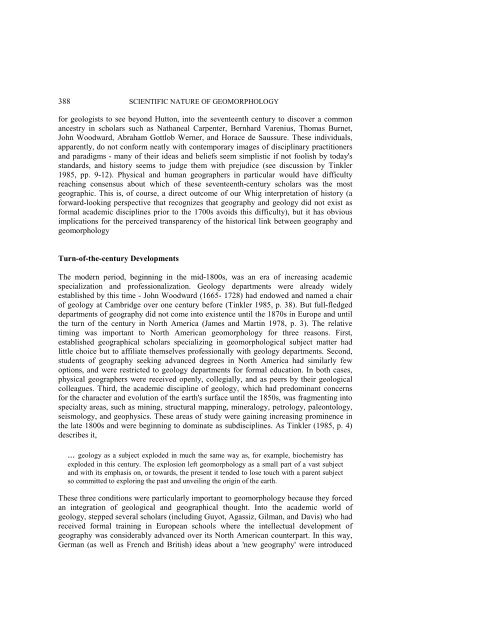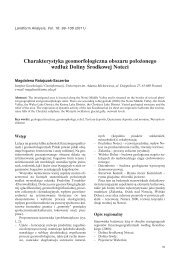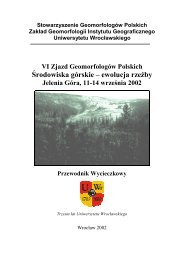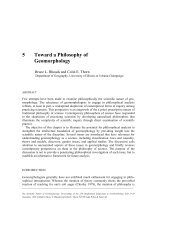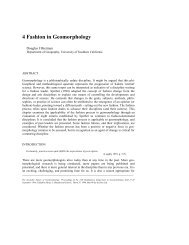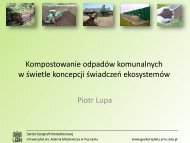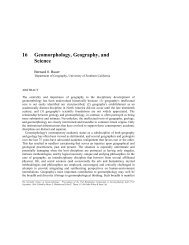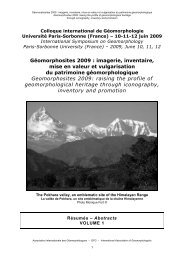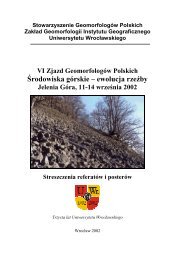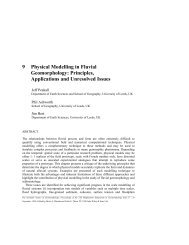Chapter 16 - Geomorphology, Geography, and Science Bernard 0
Chapter 16 - Geomorphology, Geography, and Science Bernard 0
Chapter 16 - Geomorphology, Geography, and Science Bernard 0
Create successful ePaper yourself
Turn your PDF publications into a flip-book with our unique Google optimized e-Paper software.
388 SCIENTIFIC NATURE OF GEOMORPHOLOGY<br />
for geologists to see beyond Hutton, into the seventeenth century to discover a common<br />
ancestry in scholars such as Nathaneal Carpenter, Bernhard Varenius, Thomas Burnet,<br />
John Woodward, Abraham Gottlob Werner, <strong>and</strong> Horace de Saussure. These individuals,<br />
apparently, do not conform neatly with contemporary images of disciplinary practitioners<br />
<strong>and</strong> paradigms - many of their ideas <strong>and</strong> beliefs seem simplistic if not foolish by today's<br />
st<strong>and</strong>ards, <strong>and</strong> history seems to judge them with prejudice (see discussion by Tinkler<br />
1985, pp. 9-12). Physical <strong>and</strong> human geographers in particular would have difficulty<br />
reaching consensus about which of these seventeenth-century scholars was the most<br />
geographic. This is, of course, a direct outcome of our Whig interpretation of history (a<br />
forward-looking perspective that recognizes that geography <strong>and</strong> geology did not exist as<br />
formal academic disciplines prior to the 1700s avoids this difficulty), but it has obvious<br />
implications for the perceived transparency of the historical link between geography <strong>and</strong><br />
geomorphology<br />
Turn-of-the-century Developments<br />
The modern period, beginning in the mid-1800s, was an era of increasing academic<br />
specialization <strong>and</strong> professionalization. Geology departments were already widely<br />
established by this time - John Woodward (<strong>16</strong>65- 1728) had endowed <strong>and</strong> named a chair<br />
of geology at Cambridge over one century before (Tinkler 1985, p. 38). But full-fledged<br />
departments of geography did not come into existence until the 1870s in Europe <strong>and</strong> until<br />
the turn of the century in North America (James <strong>and</strong> Martin 1978, p. 3). The relative<br />
timing was important to North American geomorphology for three reasons. First,<br />
established geographical scholars specializing in geomorphological subject matter had<br />
little choice but to affiliate themselves professionally with geology departments. Second,<br />
students of geography seeking advanced degrees in North America had similarly few<br />
options, <strong>and</strong> were restricted to geology departments for formal education. In both cases,<br />
physical geographers were received openly, collegially, <strong>and</strong> as peers by their geological<br />
colleagues. Third, the academic discipline of geology, which had predominant concerns<br />
for the character <strong>and</strong> evolution of the earth's surface until the 1850s, was fragmenting into<br />
specialty areas, such as mining, structural mapping, mineralogy, petrology, paleontology,<br />
seismology, <strong>and</strong> geophysics. These areas of study were gaining increasing prominence in<br />
the late 1800s <strong>and</strong> were beginning to dominate as subdisciplines. As Tinkler (1985, p. 4)<br />
describes it,<br />
... geology as a subject exploded in much the same way as, for example, biochemistry has<br />
exploded in this century. The explosion left geomorphology as a small part of a vast subject<br />
<strong>and</strong> with its emphasis on, or towards, the present it tended to lose touch with a parent subject<br />
so committed to exploring the past <strong>and</strong> unveiling the origin of the earth.<br />
These three conditions were particularly important to geomorphology because they forced<br />
an integration of geological <strong>and</strong> geographical thought. Into the academic world of<br />
geology, stepped several scholars (including Guyot, Agassiz, Gilman, <strong>and</strong> Davis) who had<br />
received formal training in European schools where the intellectual development of<br />
geography was considerably advanced over its North American counterpart. In this way,<br />
German (as well as French <strong>and</strong> British) ideas about a 'new geography' were introduced


